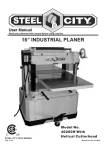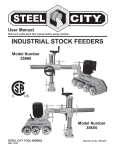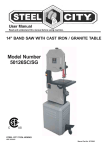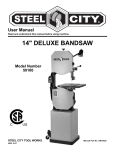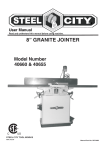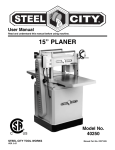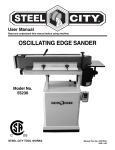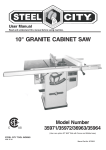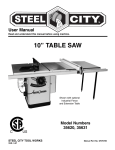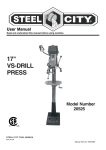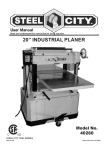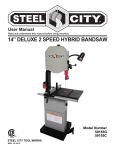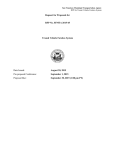Download 48115 / 48120 - Industrial Shaper w/ Parts Breakdown
Transcript
User Manual Read and understand this manual before using machine. INDUSTRIAL SHAPER Model Numbers 48115 48120 ® C US STEEL CITY TOOL WORKS VER. 1.07 Manual Part No. OR73436 w Steel City signed, tested, and de en be s ha er ap sh s hi T Industrial Shaper. n properly he W d. in m in , er om st cu inspected with you, the ovide you with years pr ill w er ap sh ur yo d, used and maintaine ed by one of ck ba is it hy w is ch hi w of trouble free service, nties in the business. ra ar w ry ne hi ac m t es ng the lo e Steel City’s th in ts uc od pr y an m of This shaper is just one is proof of our d an ry ne hi ac m ng ki or family of woodw omer satisfaction. commitment to total cust cellence each and ex r fo ve ri st to ue in nt co At Steel City we customer. For r ou u, yo of n io in op e every day and value th City Tool Works, please l ee St or er ap sh ur yo t comments abou tytoolworks.com . ci el te .s w w w at te si eb visit our w rchasing your ne pu r fo U O Y K N A H T 2 TABLE OF CONTENTS INTRODUCTION SECTION 1 Warranty .................................................................................................................................................4 SECTION 2 Product Specifications ............................................................................................................................7 SECTION 3 Accessories and Attachments ................................................................................................................7 SECTION 4 Definition of Terms ..................................................................................................................................7 SECTION 5 Feature Identification ..............................................................................................................................8 SECTION 6 General Safety........................................................................................................................................9 SECTION 7 Product Safety ......................................................................................................................................11 SECTION 8 Electrical Requirements........................................................................................................................12 SECTION 9 Unpacking & Inventory..........................................................................................................................14 SECTION 10 Assembly ..............................................................................................................................................19 SECTION 11 Adjustments ..........................................................................................................................................26 SECTION 12 Operations ............................................................................................................................................28 SECTION 13 Maintenance .........................................................................................................................................30 SECTION 14 Troubleshooting ....................................................................................................................................31 SECTION 15 Parts List...............................................................................................................................................32 INTRODUCTION This user manual is intended for use by anyone working with this machine. It should be kept available for immediate reference so that all operations can be performed with maximum efficiency and safety. Do not attempt to perform maintenance or operate this machine until you have read and understand the information contained in this manual. The drawings, illustrations, photographs, and specifications in this user manual represent your machine at time of print. However, changes may be made to your machine or this manual at any time with no obligation to Steel City Tool Works. 3 WARRANTY STEEL CITY TOOL WORKS 5 YEAR LIMITED WARRANTY Steel City Tool Works, LLC (“SCTW”) warrants all “STEEL CITY TOOL WORKS” machinery to be free of defects in workmanship and materials for a period of 5 years from the date of the original retail purchase by the original owner. SCTW will repair or replace, at its expense and at its option, any SCTW machine, machine part, or machine accessory which in normal use has proven to be defective, provided that the customer returns the product, shipping prepaid, to an authorized service center with proof of purchase and provides SCTW with a reasonable opportunity to verify the alleged defect by inspection. This warranty does not apply to defects due directly or indirectly to misuse, abuse, negligence, accidents, or lack of maintenance, or to repairs or alterations made or specifically authorized by anyone other than SCTW. Normal wear components are also excluded under this coverage. Every effort has been made to ensure that all SCTW machinery meets the highest quality and durability standards. We reserve the right to change specifications at any time due to our commitment to continuous improvement of the quality of our products. EXCEPT AS SET FORTH ABOVE, SCTW MAKES NO EXPRESS OR IMPLIED REPRESENTATIONS OR WARRANTIES WITH RESPECT TO ITS MACHINERY, OR ITS CONDITION, MERCHANTABILITY, OR FITNESS FOR ANY PARTICULAR PURPOSE OR USE. SCTW FURNISHES THE ABOVE WARRANTIES IN LIEU OF ALL OTHER WARRANTIES, EXPRESS OR IMPLIED, INCLUDING THE WARRANTIES OF MERCHANTABILITY AND FITNESS FOR A PARTICULAR PURPOSE, WHICH ARE HEREBY SPECIFICALLY DISCLAIMED. SCTW SHALL NOT BE LIABLE FOR ANY (A) SPECIAL, INDIRECT, INCIDENTAL, PUNITIVE OR CONSEQUENTIAL DAMAGES, INCLUDING WITHOUT LIMITATION LOSS OF PROFITS, ARISING FROM OR RELATED TO THIS WARRANTY, THE BREACH OF ANY AGREEMENT OR WARRANTY, OR THE OPERATION OR USE OF ITS MACHINERY, INCLUDING WITHOUT LIMITATION DAMAGES ARISING FROM DAMAGE TO FIXTURES, TOOLS, EQUIPMENT, PARTS OR MATERIALS, DIRECT OR INDIRECT LOSS CAUSED BY ANY OTHER PARTY, LOSS OF REVENUE OR PROFITS, FINANCING OR INTEREST CHARGES, AND CLAIMS BY ANY THIRD PERSON, WHETHER OR NOT NOTICE OF SUCH POSSIBLE DAMAGES HAS BEEN GIVEN TO SCTW; (B) DAMAGES OF ANY KIND FOR ANY DELAY BY OR FAILURE OF SCTW TO PERFORM ITS OBLIGATIONS UNDER THIS AGREEMENT; OR (C) CLAIMS MADE A SUBJECT OF A LEGAL PROCEEDING AGAINST SCTW MORE THAN ONE (1) YEAR AFTER SUCH CAUSE OF ACTION FIRST AROSE. The validity, construction and performance of this Warranty and any sale of machinery by SCTW shall be governed by the laws of the Commonwealth of Pennsylvania, without regard to conflicts of laws provisions of any jurisdiction. Any action related in any way to any alleged or actual offer, acceptance or sale by SCTW, or any claim related to the performance of any agreement including without limitation this Warranty, shall take place in the federal or state courts in Allegheny County, Pennsylvania. STEEL CITY TOOL WORKS 4 WARRANTY CARD Name ________________________________________________ Street _______________________________________________ 8. Apt. No. ______________________________________________ City _________________________ State ______ Zip __________ ___ Advance Phone Number_________________________________________ E-Mail ________________________________________________ 9. Model No.: ___________________________________________ Serial No. _____________________________________________ CUT HERE 3. 4. ___ Horizontal Boring Machine ___ Lathe ___ Mortiser ___ Planer ___ Panel Saw ___ Power Feeder Where did you purchase your STEEL CITY machine? Store: ____________________________________________ ___ Radial Arm Saw ___ Spindle Sander ___ Shaper ___ Table Saw City:______________________________________________ ___ Vacuum Veneer Press ___ Wide Belt Sander Other____________________________________________ How did you first learn of Steel City Tool Works? ___ Advertisement ___ Mail Order Catalog ___ Web Site ___ Friend ___ Local Store Other_______________________ 11. Which benchtop tools do you own? Check all that apply. ___ Belt Sander ___ Belt / Disc Sander ___ Drill Press ___ Band Saw ___ Grinder ___ Mini Jointer ___ Mini Lathe ___ Scroll Saw ___ Spindle / Belt Sander Other______________________ Which of the following magazines do you subscribe to? ___ American Woodworker ––– Cabinetmaker ___ American How-To ___ Family Handyman ___ ___ ___ ___ ___ ___ ___ ___ ___ ___ Fine Woodworking ___ Old House Journal ___ Popular Science ___ Today’s Homeowner ___ Woodcraft ___ Woodshop News ___ Woodwork ___ Woodworker’s Journal Other_________________ Fine Homebuilding Journal of Light Construction Popular Mechanics Popular Woodworking WOOD WOODEN Boat Woodsmith Woodworker Workbench 12. Which portable / hand held power tools do you own? Check all that apply. ___ Biscuit Jointer ___ Belt Sander ___ Dust Collector ___ Circular Saw ___ Detail Sander ___ Drill / Driver ___ Miter Saw ___ Orbital Sander ___ Palm Sander ___ Portable Thickness Planer ___ Saber Saw ___ Reciprocating Saw ___ Router Other_______________________ 13. What machines / accessories would you like to see added to the STEEL CITY line? Which of the following woodworking / remodeling shows do you watch? ___ Backyard America ____________________________________________________ ____________________________________________________ ___ The American Woodworker ___ Home Time ___ The New Yankee Workshop ___ This Old House ___ Woodwright’s Shop Other__________________________________________ 5. How many Steel City machines do you own? _____________ ___ Dust Collection ___ Jointer The following information is given on a voluntary basis and is strictly confidential. 2. ___ Master Craftsman 10. What stationary woodworking tools do you own? Check all that apply. ___ Air Compressor ___ Band Saw ___ Drill Press ___ Drum Sander Product Description:_____________________________________ 1. How would you rank your woodworking skills? ___ Simple ___ Intermediate 14. What new accessories would you like to see added? ____________________________________________________ ____________________________________________________ What is your annual household income? ___ $20,000 to $29,999 ___ $30,000 to $39,999 ___ $40,000 to $49,999 ___ $50,000 to $59,999 ___ $60,000 to $69,999 ___ $80,000 to $89,999 15. Do you think your purchase represents good value? ___Yes ___ 70,000 to $79,999 ___ $90,000 + ___ No 16. Would you recommend STEEL CITY products to a friend? 6. ___ Yes What is your age group? ___ 20 to 29 years ___ 40 to 49 years ___ 60 to 69 years ___ 30 to 39 years ___ 50 to 59 years ___ 70 + years ___ No 17. Comments: ____________________________________________________ ____________________________________________________ 7. ____________________________________________________ ____________________________________________________ ____________________________________________________ How long have you been a woodworker? ___ 0 to 2 years ___ 2 to 8 years ___ 8 to 20 years ___ over 20 years 5 FOLD ON DOTTED LINE PLACE STAMP HERE Steel City Tool Works P.O. Box 10529 Murfreesboro, TN 37129 FOLD ON DOTTED LINE 6 PRODUCT SPECIFICATIONS Spindles Furnished 3/4”, 1” Voltage 230V Spindle Speeds 7000 / 10,000 RPM Phase Single Capacity Under Nut 3 1/2” Hertz 60 Spindle Travel 3” RPM 3450 Table Size (with extension) 31” x 28 1/2” Table Height 34 “ Insert Openings 1-3/8”, 2-3/4”, 4”, 5” Footprint 23-1/4” x 20-3/4” Table T-Slot 3/4” x 3/8” Width 28-1/2” Forward and Reversing Yes Depth 31” Fence Wood Laminate Height 48” Router Collet Yes (1/4”, 1/2”) Net Weight 370 lbs. Dust Port Size 4” PRODUCT DIMENSIONS SHIPPING DIMENSIONS MOTOR Width 24-1/2” Type Induction, TEFC Depth 29-1/2” Horsepower 3HP Height 40” Amps 14 Gross Weight 395 lbs. ACCESSORIES AND ATTACHMENTS There are a variety of accessories available for your Steel City Product. For more information on any accessories associated with this and other machines, please contact your nearest Steel City distributor, or visit our website at: www.steelcitytoolworks.com. DEFINITION OF TERMS Arbor – A shaft, driven by the shaper motor that turns the cutting tools. Miter gauge – A tool that slides in a slot on the table. A miter gauge can be adjusted to different angles and is used to slide the stock past the cutterhead. Collet – The sleeve that grips the shank of a router bit. Pitch – A sticky sap based residue that comes from wood products. Featherboard – A piece of wood with thin “fingers” that hold a board against a fence or down against the table. Runout – The amount of wobble in the spindle. Fence – A straight guide used to keep a board a set distance from the cutterhead. Template – A pattern to guide the marking or cutting of a shape. Kickback – When a workpiece is thrown back, in the opposite direction the cutter is turning. 7 FEATURE IDENTIFICATION D D C E F B G H A A. Raise/Lower Handwheel B. Arbor Stabilizer Knob C. Fence D. Fence Lock Knobs E. Miter Gauge F. Power Switch G. Cutterhead Rotation Switch H. Adjustable Depth Scale 8 GENERAL SAFETY ! WARNING ! WARNING TO AVOID serious injury and damage to the machine, read and follow all Safety and Operating Instructions before assembling and operating this machine. This manual is not totally comprehensive. It does not and can not convey every possible safety and operational problem which may arise while using this machine. The manual will cover many of the basic and specific safety procedures needed in an industrial environment. Exposure to the dust created by power sanding, sawing, grinding, drilling and other construction activities may cause serious and permanent respiratory or other injury, including silicosis (a serious lung disease), cancer, and death. Avoid breathing the dust, and avoid prolonged contact with dust. The dust may contain chemicals known to the State of California to cause cancer, birth defects or other reproductive harm. All federal and state laws and any regulations having jurisdiction covering the safety requirements for use of this machine take precedence over the statements in this manual. Users of this machine must adhere to all such regulations. Some examples of these chemicals are: • Lead from lead-based paints. • Crystalline silica from bricks, cement and other masonry products. • Arsenic and chromium from chemically-treated lumber. Below is a list of symbols that are used to attract your attention to possible dangerous conditions. ! This is the safety alert symbol. It is used to alert you to potential personal injury hazards. Obey all safety messages that follow this symbol to avoid possible injury or death. ! Always operate tool in well ventilated area and provide for proper dust removal. Use a dust collection system along with an air filtration system whenever possible. Always use properly fitting NIOSH/OSHA approved respiratory protection appropriate for the dust exposure, and wash exposed areas with soap and water. DANGER Indicates an imminently hazardous situation which, if not avoided, WILL result in death or serious injury. ! 1. To avoid serious injury and damage to the machine, read the entire User Manual before assembly and operation of this machine. WARNING Indicates a potentially hazardous situation which, if not avoided, COULD result in death or serious injury. ! CAUTION ! WARNING Indicates a potentially hazardous situation, if not avoided, MAY result in minor or moderate injury. It may also be used to alert against unsafe practices. 2. ALWAYS wear eye protection. Any machine can throw debris into the eyes during operations, which could cause severe and permanent eye damage. Everyday eyeglasses are NOT safety glasses. ALWAYS wear Safety Goggles (that comply with ANSI standard Z87.1) when operating power tools. CAUTION CAUTION used without the safety alert symbol indicates a potentially hazardous situation which, if not avoided, may result in property damage. NOTICE This symbol is used to alert the user to useful information about proper operation of the machine. 9 ! 11. DO NOT FORCE the machine to perform an operation for which it was not designed. It will do a safer and higher quality job by only performing operations for which the machine was intended. WARNING 12. DO NOT stand on a machine. Serious injury could result if it tips over or you accidentally contact any moving part. 3. ALWAYS wear hearing protection. Plain cotton is not an acceptable protective device. Hearing equipment should comply with ANSI S3.19 Standards. ! 13. DO NOT store anything above or near the machine. 14. DO NOT operate any machine or tool if under the influence of drugs, alcohol, or medication. WARNING 15. EACH AND EVERY time, check for damaged parts prior to using any machine. Carefully check all guards to see that they operate properly, are not damaged, and perform their intended functions. Check for alignment, binding or breakage of all moving parts. Any guard or other part that is damaged should be immediately repaired or replaced. 4. ALWAYS wear a NIOSH/OSHA approved dust mask to prevent inhaling dangerous dust or airborne particles. 16. Ground all machines. If any machine is supplied with a 3-prong plug, it must be plugged into a 3contact electrical receptacle. The third prong is used to ground the tool and provide protection against accidental electric shock. DO NOT remove the third prong. 5. ALWAYS keep the work area clean, well lit, and organized. DO NOT work in an area that have slippery floor surfaces from debris, grease, and wax. 6. ALWAYS unplug the machine from the electrical receptacle when making adjustments, changing parts or performing any maintenance. 17. Keep visitors and children away from any machine. DO NOT permit people to be in the immediate work area, especially when the machine is operating. 7. AVOID ACCIDENTAL STARTING. Make sure that the power switch is in the “OFF” position before plugging in the power cord to the electrical receptacle. ! 18. KEEP protective guards in place and in working order. 19. MAINTAIN your balance. DO NOT extend yourself over the tool. Wear oil resistant rubber soled shoes. Keep floor clear of debris, grease, and wax. WARNING 20. MAINTAIN all machines with care. ALWAYS KEEP machine clean and in good working order. KEEP all blades and tool bits sharp. 21. NEVER leave a machine running, unattended. Turn the power switch to the OFF position. DO NOT leave the machine until it has come to a complete stop. 8. AVOID a dangerous working environment. DO NOT use electrical tools in a damp environment or expose them to rain or moisture. ! 22. REMOVE ALL MAINTENANCE TOOLS from the immediate area prior to turning the machine ON. WARNING 23. SECURE all work. When it is possible, use clamps or jigs to secure the workpiece. This is safer than attempting to hold the workpiece with your hands. 24. STAY ALERT, watch what you are doing, and use common sense when operating any machine. DO NOT operate any machine tool while tired or under the influence of drugs, alcohol, or medication. A moment of inattention while operating power tools may result in serious personal injury. 9. CHILDPROOF THE WORKSHOP AREA by removing switch keys, unplugging tools from the electrical receptacles, and using padlocks. 10. DO NOT use electrical tools in the presence of flammable liquids or gasses. 10 25. USE ONLY recommended accessories. Use of incorrect or improper accessories could cause serious injury to the operator and cause damage to the machine. If in doubt, DO NOT use it. 28. SAVE these instructions and refer to them frequently and use them to instruct other users. 29. Information regarding the safe and proper operation of this tool is also available from the following sources: 26. THE USE of extension cords is not recommended for 230V equipment. It is better to arrange the placement of your equipment and the installed wiring to eliminate the need for an extension cord. If an extension cord is necessary, refer to the chart in the Grounding Instructions section to determine the minimum gauge for the extension cord. The extension cord must also contain a ground wire and plug pin. Power Tool Institute 1300 Summer Avenue Cleveland, OH 44115-2851 www.powertoolinstitute.org National Safety Council 1121 Spring Lake Drive Itasca, IL 60143-3201 American National Standards Institute 25 West 43rd Street, 4th floor New York, NY 10036 www.ansi.org 27. Wear proper clothing, DO NOT wear loose clothing, gloves, neckties, or jewelry. These items can get caught in the machine during operations and pull the operator into the moving parts. Users must wear a protective cover on their hair, if the hair is long, to prevent it from contacting any moving parts. ANSI 01.1 Safety Requirements for Woodworking Machines, and the U.S. Department of Labor regulations www.osha.gov PRODUCT SAFETY 1. Serious personal injury may occur if normal safety precautions are overlooked or ignored. Accidents are frequently caused by lack of familiarity or failure to pay attention. Obtain advice from supervisor, instructor, or another qualified individual who is familiar with this machine and its operations. 6. Safety decals are on this machine to warn and direct you to how to protect yourself or visitors from personal injury. These decals MUST be maintained so that they are legible. REPLACE decals that are not legible. 7. DO NOT leave the unit plugged into the electrical outlet. Unplug the unit from the outlet when not in use and before servicing, performing maintenance tasks, or cleaning. 2. Every work area is different. Always consider safety first, as it applies to your work area. Use this machine with respect and caution. Failure to do so could result in serious personal injury and damage to the machine. 8. ALWAYS turn the power switch “OFF” before unplugging the shaper. 3. Prevent electrical shock. Follow all electrical and safety codes, including the National Electrical Code (NEC) and the Occupational Safety and Health Regulations (OSHA). All electrical connections and wiring should be made by qualified personnel only. ! ! WARNING 9. DO NOT handle the plug or shaper with wet hands. WARNING 10. USE accessories only recommended by Steel City. 4. TO REDUCE the risk of electrical shock. DO NOT use this machine outdoors. DO NOT expose to rain or moisture. Store indoors in a dry area. 11. DO NOT pull the shaper by the power cord. NEVER allow the power cord to come in contact with sharp edges, hot surfaces, oil or grease. 12. DO NOT unplug the shaper by pulling on the power cord. ALWAYS grasp the plug, not the cord. 5. STOP using this machine, if at any time you experience difficulties in performing any operation. Contact your supervisor, instructor or machine service center immediately. 13. REPLACE a damaged cord immediately. DO NOT use a damaged cord or plug. 11 14. DO NOT use the shaper as a toy. DO NOT use near or around children. 23. SET UP operations whenever possible to have the cutters under the workpiece. 15. KEEP hands away from cutting tool. 24. When shaping with a starting pin and rub collar, BE SURE that the workpiece is of sufficient size to insure control. It is best to shape a larger piece and then cut to size on a table saw. 16. NEVER run stock between the fence and the cutter. 17. ALWAYS use a miter gauge and clamp attachment when shaping small pieces. The fence should be removed during this operation. 25. BE SURE that there is sufficient bearing surface of the workpiece on the rub collar to insure support throughout the operation. 18. ALWAYS feed against the rotation of the cutter. 26. MAKE SURE cutters are properly secured before starting shaper. 19. The wooden fence halves SHOULD BE adjusted endwise so the opening is never more than is required to clear the cutter. 20. KEEP cutters sharp and free from rust and pitch. 27. USE guards, guides, and hold-down wherever possible. 21. ONLY use flat workpieces in the shaper, never use warped or twisted lumber. 28. ALWAYS use proper speed setting for the cutter being used. 22. NEVER take off too much material in one pass. Make several lighter passes. 29. DO NOT perform any operation freehand. Use the fence for straight shaping, the miter gauge for end shaping, and a starting pin and collar for curve shaping. ELECTRICAL REQUIREMENTS ! WARNING The switch provided with your shaper is designed for 230 volt single phase usage only. The switch has a plug that is designed to plug into a 230 volt outlet. There are many different configurations for 230 volt outlets, so it is conceivable that the configuration of the plug may not match the configuration of your existing outlet. If this is the case, you will have to replace the plug with a UL/CSA approved plug that matches the configuration of your 230V outlet. To reduce the risk of electric shock, follow all electrical and safety codes, including the National Electric Code (NEC) and the Occupational Safety and Health Regulations (OSHA). All electrical connections and wiring should be made by qualified personnel only. 12 GROUNDING INSTRUCTIONS ! The motor supplied with your machine is a 230 volt, single phase motor. Never connect the green or ground wire to a live terminal. WARNING A machine with a 230 volt plug should only be connected to an outlet having the same configuration as the plug. This machine MUST BE GROUNDED while in use to protect the operator from electric shock. EXTENSION CORDS In the event of a malfunction or breakdown, GROUNDING provides the path of least resistance for electric current and reduces the risk of electric shock. The plug MUST be plugged into a matching electrical receptacle that is properly installed and grounded in accordance with ALL local codes and ordinances. ! If a plug is provided with your machine DO NOT modify the plug. If it will not fit your electrical receptacle, have a qualified electrician install the proper connections to meet all electrical codes local and state. All connections must also adhere to all of OSHA mandates. WARNING To reduce the risk of fire or electrical shock, use the proper gauge of extension cord. When using an extension cord, be sure to use one heavy enough to carry the current your machine will draw. IMPROPER ELECTRICAL CONNECTION of the equipment-grounding conductor can result in risk of electric shock. The conductor with the green insulation (with or without yellow stripes) is the equipment-grounding conductor. DO NOT connect the equipment-grounding conductor to a live terminal if repair or replacement of the electric cord or plug is necessary. The smaller the gauge-number, the larger the diameter of the extension cord is. If in doubt of the proper size of an extension cord, use a shorter and thicker cord. An undersized cord will cause a drop in line voltage resulting in a loss of power and overheating. Check with a qualified electrician or service personnel if you do not completely understand the grounding instructions, or if you are not sure the tool is properly grounded. USE ONLY a 3-wire extension cord that has a 3-prong grounding plug and a 3-pole receptacle that accepts the machine’s plug. ! If you are using an extension cord outdoors, be sure it is marked with the suffix “W-A” (“W” in Canada) to indicate that it is acceptable for outdoor use. PLUGS/RECEPTACLES ! CAUTION Make certain the extension cord is properly sized, and in good electrical condition. Always replace a worn or damaged extension cord immediately or have it repaired by a qualified person before using it. WARNING Protect your extension cords from sharp objects, excessive heat, and damp or wet areas. • Electrocution or fire could result if this machine is not grounded properly or if the electrical configuration does not comply with local and state electrical codes. MINIMUM RECOMMENDED GAUGE FOR EXTENSION CORDS (AWG) 230 VOLT OPERATION ONLY • MAKE CERTAIN the machine is disconnected from power source before starting any electrical work. • MAKE SURE the circuit breaker does not exceed the rating of the plug and receptacle. 13 25’ LONG 50’ LONG 100’ LONG 0 to 6 Amps 16 AWG 16 AWG 14 AWG 6 to 8 Amps 16 AWG 16 AWG 12 AWG 8 to 12 Amps 14 AWG 14 AWG 10 AWG 12 to 15 Amps 12 AWG 12 AWG 10 AWG 15 to 20 Amps 10 AWG 10 AWG Not recommended UNPACKING & INVENTORY ! can be removed by spraying WD-40 on them and wiping it off with a soft cloth. This may need redone several times before all of the protective coatings are removed completely. WARNING After cleaning, apply a good quality paste wax to any unpainted surfaces. Make sure to buff out the wax before assembly. • The machine is heavy, two people are required to unpack and lift. Compare the items to inventory figures; verify that all items are accounted for before discarding the shipping box. • Use a safety strap to avoid tip over when lifting machine. Check shipping carton and machine for damage before unpackaging. Carefully remove packaging materials, parts and machine from shipping carton. Always check for and remove protective shipping materials around motors and moving parts. Lay out all parts on a clean work surface. ! WARNING If any parts are missing, do not attempt to plug in the power cord and turn “ON” the machine. The machine should only be turned “ON” after all the parts have been obtained and installed correctly. For missing parts, contact Steel City at 1-877-SC4-TOOL. Remove any protective materials and coatings from all of the parts and the shaper. The protective coatings A. Main Fence Casting B. Laminated Fence Halves (2) B A 14 C. Spindle Wrenches (2) D. Open End Wrenches (2) C F. F E E. 3-1/2-in Overhead Guard 6-in Overhead Guard with Mounting Rod and Fasteners NOTE: Rod and fasteners are interchangeable and are to be used on both overhead guards. D G. M6 x 20 socket head cap screw (4) H M6 Nylock Hex Nut (4) G I. M6 Lock Washer (4) H J. M6 Flat Washer (4) K L I K. Mounting Post J L. Draw Bar M. Router Collett N. 3/4-in. Spindle O. 1-in. Spindle O N Q P. Starting Pin Q. Spacers (6) R. Special Washer (2) M P R 15 W V U S X Z AA T Y S. Fence Lock Knobs with Flat Washers T. Top Cover Lock Knobs with Flat Washers U. Top Cover V. Guard Mounting Bracket W. Hold Down Bracket X. Barrier Guard with Shaft Y. Chip Deflector with Shaft Z. Extension Rod AA. Lock Handles with Flat Washers (2) 16 HH BB CC DD BB BB FF EE GG BB. Table Inserts (3) CC. Dust Chute (Small Half) DD. Dust Chute (Large Half) EE. Motor Cover FF. Handwheel GG. Extension Wing HH. Miter Gauge Assembly 17 OO PP II JJ KK LL QQ RR MM SS NN II. M5 x 10mm Pan Head Screw(6) JJ. M5 Flat Washer(6) KK. M5 Lock Washer(6) LL. M6 x 12mm Pan Head Screw(6) MM. M6 Flat Washer(6) NN. M6 Lock Washer(6) OO. M8 x 20mm Socket Head Cap Screw PP. M10 x 65mm Socket Head Cap Screw QQ. M10 Flat Washer(2) RR. M10 Lock Washer SS. M10 Hex Nut 18 ASSEMBLY Before beginning assembly, take note of the following precautions and suggestions In order to connect to a dust collection system, you will need to attach the dust port (A) to the rear of the machine using four M5 x 10mm pan head screws. SEE FIG. 1. The shaper is bolted to the pallet. Before attempting any of the assembly procedures remove all of the loose parts and hardware from the inside of the shaper and unbolt the machine from the pallet. Fig. 1 A CAUTION FLOOR ! This tool distributes a large amount of weight over a small area. Make certain that the floor is capable of supporting both the weight of the machine and the operator. The floor should also be a level surface. If the unit wobbles or rocks once in place, be sure to eliminate by using shims. WORKING CLEARANCES Take into consideration the size of the material to be processed. Make sure that you allow enough space for you to operate the machine freely. REMOVING SHIPPING STRAP There is a metal strap (A) located inside of the cabinet that is bolted to both the motor and the cabinet to help prevent damage during shipping. This strap must be removed prior to operating the shaper. SEE FIG. 2. OUTLET PLACEMENT Outlets should be located close enough to the machine so that the power cord or extension cord is not in an area where it would cause a tripping hazard. Be sure to observe all electrical codes if installing new circuits and/or outlets. ! Fig. 2 B WARNING A • DO NOT assemble the Shaper until you are certain that the machine is not plugged in and the power switch is in the OFF position. • DO NOT connect the machine to the power source until the machine is completely assembled and you read and understand the entire User Manual. C DUST COLLECTION Since the Shaper generates a large amount of dust and wood shavings, using an appropriate Dust Collection system is highly recommended. Make certain to construct your ducting to achieve optimum airflow and allow for adequate working clearances. To remove: 1. Remove the two hex head cap screws (B) located on the outside of the shaper. SEE FIG. 2. 2. A third bolt (C) is located behind the motor attaching the lower end of the strap to the motor plate. Remove using an open end wrench 19 2. Install the larger half of the dust chute, making sure that the notch (A) lines up with the shaft (B). Fasten into place using four M5 x 10mm pan head screws, four M5 lock washers, and four M5 flat washers. SEE FIG. 4. INSTALLING DUST CHUTE The dust chute comes in two halves. The smaller piece fits to the left of the shaft and the larger piece with the notch cut out, goes to the right of the shaft. To install: 1. Insert the smaller half of the dust chute into the cabinet and fasten using two M5 x 10mm pan head screws, two M5 lock washers, and two M5 flat washers. SEE FIG. 3. Fig. 4 Fig. 3 A B 3. Once dust chute is installed, place rubber boot (C) around the shaft. SEE FIG. 5. Fig. 5 C 20 ATTACHING SWITCH INSTALLING MOTOR COVER The switch is designed to be mounted on a swivel arm so that it can be put in various positions depending on the job. To attach The motor cover provides easy access to the motor and is located on the side of the shaper. Once all of the internal parts of the shaper have been assembled, you can install the motor cover. Attach the motor cover to the cabinet using six M6 x 12mm pan head screws, six M6 lock washers and six M6 flat washers. SEE FIG. 8. 1. Insert the arm (A) into the bracket on the saw and line up the hole on the arm (B) with the hole on the bracket (C). SEE FIG. 6. Fig. 8 Fig. 6 C B A ATTACHING EXTENSION WING The shaper has one extension wing that needs to be mounted before it can be operated. 2. Fasten the swivel arm to the bracket using one M10 x 65mm Socket Head Cap Screw, two M10 flat washers, one M10 lock washer, and one M10 hex nut. To install: 1. Attach the extension wing to the table using three M10 x 35MM socket head cap screws, three M10 lock washers, and three M10 flat washers. 3. Position the swivel arm so that the other hole in the swivel arm lines up with one of the three holes in the bracket (D) and secure in place using one M8 x 20mm socket head cap screw. SEE FIG. 7. 2 Slide the extension wing until the front of the wing is flush with the main table. 3. Using a straight edge, align the extension wing to the table and securely tighten the three socket head cap screws. SEE FIG 9. Fig. 7 Fig. 9 D 21 3. Insert the draw bar (A) through the bottom of the quill, making sure that the beveled edge of the drawbar nut (B) is facing upwards. SEE FIG 12. ATTACHING HANDWHEEL The handwheel is used to raise and lower the spindle. To install: Fig. 12 1. Line up the keyway in the handwheel with the key on the shaft. 2. Insert handwheel over the shaft. 3. Secure handwheel to the shaft by tightening set screw (A). SEE FIG 10. Fig. 10 A B A INSTALLING SPINDLE ! 4. Use the spindle wrench to hold the top flats on the spindle while tightening the draw bar nut using an open end wrench. SEE FIG 13. WARNING MAKE CERTAIN THAT THE SHAPER IS DISCONNECTED FROM THE POWER SOURCE. Fig. 13 1. Select the appropriate spindle for your shaping operation. This Shaper comes equipped with a 3/4” spindle, a 1” spindle, and a router collet that accepts 1/4” and 1/2” router bits. 2. Insert the end of the spindle into quill of the shaper. MAKE CERTAIN to align the keyway in the spindle with the tab on the quill. SEE FIG 11. Fig. 11 KEYWAY 22 SETTING TABLE INSERTS ATTACHING CUTTERS AND COLLARS TO SPINDLES The table inserts are preinstalled at the factory. They should be adjusted so that the top surface of the insert is level with the tabletop. If any adjustment is necessary: ! ! WARNING MAKE CERTAIN THAT THE SHAPER IS DISCONNECTED FROM THE POWER SOURCE. WARNING MAKE CERTAIN THAT THE SHAPER IS DISCONNECTED FROM THE POWER SOURCE. 1. When attaching a cutter, remember to position the cutter as close to the bottom of the spindle as possible. 1. Remove the three screws in the top of the insert. 2. Remove both spindle nuts (A) and special washer (B). SEE FIG 15. 2. With the screws removed, you can see the three insert leveling screws (A). SEE FIG 14. Fig. 15 Fig. 14 B A D C A 3. Decide which collars you will need to use, if any, and place over the spindle. 3. Using a 6mm hex wrench, turn the adjusting screws so that the insert sits flush with the table. 4. Attach the cutter (D) to the spindle. 5. Add collar (if any) and then attach the special washer (B). Figure 15 shows a collar (C) installed above the cutter. 4. Replace the screws removed in step 1. ! WARNING MAKE CERTAIN that the special washer goes on just before you replace the spindle nuts. This washer prevents the spindle nut(s) from loosening if the cutter is stalled. 6. Replace spindle nuts (A) and tighten using the spindle wrenches. 23 6. Attach Guard Mounting Bracket (D) to the Top Cover (E) using four M6 x 20mm Socket Head Cap Screws, four M6 flat washers, four M6 lock washers, and four M6 Nylock hex nuts. SEE FIG. 18. ASSEMBLING FENCE ! WARNING MAKE CERTAIN THAT THE SHAPER IS DISCONNECTED FROM THE POWER SOURCE. Fig. 18 1. Install the fence by placing the main fence casting (A) on the table surface. SEE FIG 16. D Fig. 16 F F B A E 2. Use the two locking handles (B) provided to secure the fence casting to the table by threading the handles into the holes in the table located slightly behind the spindle opening. 7. With the Guard Mounting Bracket now attached to the Top Cover, fasten the top cover to the fence casting using the two supplied Lock Knobs (F) and flat washers. 3. Attach the laminated wooden fence halves by placing one flat washer (not shown) over the fence lock knob (A), insert the handle through the hole (B) in the fence, and thread into the bracket on the back of the laminated wooden fence half. SEE FIG. 17. 8. There are several types of guards that should be attached to the shaper fence depending on the operation that you are performing. Figures 19 and Fig 20 show how the Barrier Guard (G), the Hold Down Bracket (H), the Chip Deflector (I), and the Overhead Guard(J) are attached to the Fence Assembly SEE FIGS. 19 and 20. Fig. 17 C Fig. 19 B I A 4. Tighten fence lock knob until the fence half is securely in place. H NOTE: The fence lock handles are spring loaded and can be adjusted by pulling out on the handle and repositioning on the shaft. G 5. Repeat steps 3-4 to attach the remaining fence half. 24 NOTICE: Guard segments will need to be repositioned for the operation being attempted. The guards should be as close as possible without interfering with the travel of the workpiece or cutter. Fig. 20 H J 25 ADJUSTMENTS CHANGING SPEEDS RAISING AND LOWERING THE SPINDLE This shaper is constructed with a 2 step pulley on both the motor pulley (A) and on the spindle pulley (B). This two step configuration allows for speeds of either 7,000 RPM or 10,000 RPM. With the belt on the larger step of the motor pulley and the smaller step on the spindle pulley, the spindle speed will be 10,000 RPM. Conversely, with the belt on the smaller step of the motor pulley and the larger step on the spindle pulley, the spindle speed would be 7,000 RPM. The belt can be moved from one step on the pulley to the other by simply walking the belt. SEE FIG. 21. The Spindle can be raised or lowered by loosening the stabilizer knob (B) and turning the handwheel (C). To raise the spindle height, turn the handwheel clockwise. To lower the spindle height, turn the handwheel counterclockwise. The adjustable scale (D) on the front of the shaper shows the height of the spindle and can be positioned to set your zero mark at multiple locations. Once the spindle is in the desired location you can stabilize the position by turning the knob (B) located on the side of the machine. SEE FIG. 22. Fig. 22 Fig. 21 D A B C B A FENCE POSITIONING ! WARNING The two faces of the fence are independent of one another and can be set at different positions to allow for different shaping tasks. To adjust The two settings listed above are the only combinations available for this shaper. DO NOT attempt to skew the belt so that it rides on either both small pulleys or both large pulleys. Doing so may result in damage to the machine and/or injury to the operator. 1. Loosen lock lever (A). SEE FIG 23. Fig. 23 REVERSING SPINDLE ROTATION The shaper is equipped with a switch (A) that controls which way the cutter spins. Turning the switch to left runs the cutter in the forward direction, while turning it to the right runs the cutter in the reverse direction. When the switch is positioned in the middle , as shown in Fig 22, this is the neutral position. SEE FIG 22. ! A WARNING DO NOT attempt to change the spindle rotation while the machine is running. Turn the machine “OFF” and wait for the spindle to come to a complete stop before changing the rotation. B 26 2. Adjust the position of the fence by turning the adjustment knob (B) FENCE ALIGNMENT 3. When the fence is in the desired position, retighten the lock lever. Before using the shaper, it is important to make sure that the two fence faces are parallel. Use the following steps to ensure the parallelism of the two fence halves. 4. Repeat this process for the other side of the fence, if necessary. 1. Use a straight edge that is long enough to span the length of the entire fence and position it up against both fence halves (A). SEE FIG 25. NOTE: There are two sets of holes on the table top for attaching the fence. The most common set-up positions the fence so that it runs parallel to the miter slot. The fence can, however, be rotated 90° from the position by using the second set of holes in the table top. Fig. 25 BELT TENSION The belt tension is set at the factory and should not need adjustment on initial setup. The belt will need occasional adjustment as the belt will stretch over time. The belt should yield 1/4” of deflection when squeezed together at the midpoint. To adjust belt tension: ! WARNING A MAKE CERTAIN THAT THE SHAPER IS DISCONNECTED FROM THE POWER SOURCE. 1. Loosen the two hex head bolts (A). SEE FIG 24. 2. Slide the motor and bracket assembly (B) away from the spindle cartridge (C) until the slack is removed from the belt. 3. Retighten the two hex bolts loosened in step 1. Fig. 24 B C NOTE: Before placing the straight edge up against the fence, make certain that the fence lock knobs (B) are securely tightened. A 2. Adjust the fence faces so that they are as close as possible to the same parallel position. 27 OPERATIONS ! SHAPING USING THE FENCE WARNING Using the fence is the safest method of shaping. Most straight cuts that use the fence for support can be performed by following the guidelines below MAKE CERTAIN THAT THE SHAPER IS DISCONNECTED FROM THE POWER SOURCE. 1. If performing a cut where a portion of the workpiece is not touched by the cutterhead, both sides of the fence will be set at the same depth. ! WARNING 2. When performing a cut where the entire edge of the workpiece is removed, the fence must be positioned differently. If the fence halves are kept in line, once the workpiece passes through the cutterhead, the shaped edge would no longer be supported against the fence. To prevent this, the outfeed side of the fence must be positioned further out to compensate for the material being removed. Advance the outfeed side of the fence until it contacts the shaped edge of the workpiece. ALWAYS wear eye protection. Any machine can throw debris into the eyes during operations, which could cause severe and permanent eye damage. Everyday eyeglasses are NOT safety glasses. ALWAYS wear Safety Goggles (that comply with ANSI standard Z87.1) when operating power tools. ! 3. If using a miter gauge, the infeed side of the fence MUST be parallel with the miter slot. Also make certain that the outfeed side of the fence is positioned out of the way so that it does not contact the workpiece after it passes through the cutterhead. WARNING FREEHAND SHAPING Freehand Shaping is shaping without the use of a miter gauge or fence. Beginning the cut is the most dangerous part of freehand shaping. Many times when the workpiece first contacts the cutter, the workpiece will tend to kickback or jerk, which can surprise the operator. To help reduce the frequency of these incidents and increase the safety aspect of freehand shaping, a starting pin is provided with your shaper. This pin will allow you to anchor and slowly pivot the workpiece into the cutter at the beginning of the cut. When freehand shaping, it is always best to use a template jig. ALWAYS wear a NIOSH/OSHA approved dust mask to prevent inhaling dangerous dust or airborne particles. NOTICE The following section was designed to give instructions on the basic operations of this shaper. However, it is in no way comprehensive of every shaper application. It is strongly recommended that you read books, trade magazines, or get formal training to maximize the potential of your shaper and to minimize the risks. ! WARNING Use EXTREME care when freehand shaping. With the fence removed, more of the cutter is exposed increasing the risk of injury. To set up the shaper for freehand operation 1. Remove the fence assembly from the shaper 2. Insert the starting pin (A) in the most suitable hole (B) on the table insert. SEE FIG 26, page 29. 28 Fig. 26 B USING COLLARS ! WARNING B When shaping workpieces that have irregular shapes, it is essential to use a collar. There are three basic types of setup for the collar. Each setup has it’s advantages and disadvantages A Below the Cutter The advantage of the collar being positioned below the cutter is that the user can see the progress of the cut. While this method provides a good view of the cut being made, the disadvantage is that any lifting of the workpiece, even slightly, will cause the cutter to gouge the wood and ruin the workpiece. SEE FIG 28. B Fig. 28 CUTTER WORKPIECE 3. Attach the Mounting post (C) to the table using two provided socket head cap screws and attach overhead (D) guard to the post. SEE FIG. 27. Fig. 27 COLLAR COLLAR BELOW THE CUTTERHEAD Above the Cutter This type of setup is the safest of the three and produces the most consistent results. Two advantages of this setup are that D C 1. The cut will not be affected by slight variations in the thickness of the workpiece 2. The workpiece will not be gouged if you accidentally lift it off the table. If the workpiece lifts off the table, simply run it though the cutter again to produce a finished cut The only disadvantage of this type of setup is that the user will not be able to see the cut being made as it will be on the underside of the workpiece. SEE FIG. 29. Fig. 29 WORKPIECE 4. Use a hold down jig or rubberized push blocks to support or guide the workpiece and help protect your hands from injury. COLLAR 5. Place the workpiece against the starting pin. 6. Slowly pivot and feed the workpiece into the cutter. Try to avoid starting your cut on the corner of a workpiece to help reduce the risk of a kickback. 7. Once the cut is started, the workpiece should be pulled away from the starting pin. CUTTER COLLAR ABOVE THE CUTTER 29 Between two Cutters Fig. 30 The advantage of this setup is that you can make two profile cuts in a single pass so it is frequently used when both edges of the workpiece are to be shaped. The disadvantage with this method, like the “Below the Cutter” method, is that any accidental lifting of the workpiece will cause gouging and ruin the workpiece. SEE FIG. 30. CUTTER COLLAR WORKPIECE CUTTER COLLAR BETWEEN TWO CUTTERS MAINTENANCE This shaper requires very little maintenance other than minor lubrication and cleaning. The following sections detail what will need to be done in order to assure continued operation of your shaper. MODEL 48115 ONLY The tabletop is an unfinished metal surface that, over time, will accumulate rust if not properly cared for. When the shaper is not in use, keep a light coat of WD-40 on the table top as this will help prevent rust from occurring. If rust has already accumulated on the table, use WD-40 and a fine steel wool to get rid of the rust. Using a quality paste wax on the tabletop and wings is a good preventative measure to help prevent rust from forming. LUBRICATION The shaper has sealed lubricated bearings in the motor housing and the arbor assembly that do not require any additional lubrication from the operator. CLEANING MODEL 48120 ONLY Keep the inside of the cabinet clear of saw dust and wood chips. With the shaper unplugged, vacuum out the inside of the cabinet or blow out the inside with an air hose. Be sure to use air pressure no higher than 50 P.S.I. as high pressure air may damage insulation. The table top is designed to be maintenance free and, under normal shop conditions, the Titanium Nitrite (TiN) coating will minimize the chance of rust forming on the table top. While the distinctive gold color of your Steel City cast-iron top is an indication that the surface is protected against rust and corrosion, that protection does not diminish if the gold color is worn away by abrasion due to normal use over time. A paste wax may be applied to the table top to give it a shiny appearance. ! WARNING Be sure to wear protective eyewear and dust mask when cleaning out the cabinet of the shaper. 30 TROUBLESHOOTING GUIDE PROBLEM LIKELY CAUSE(S) SOLUTION The shaper does not start or the breaker trips. 1. The supply circuit has low voltage, or high resistance. 1. If you are unqualified to test voltage, determine circuit loads, or rewire electrical connections, contact a qualified electrician. 2. The motor start capacitor is open or shorted. 2. Unplug the shaper and inspect the capacitor for oily residue, bubbled plastic, foul odor, and test and replace accordingly. 3. Forward/reverse switch is in the neutral position. 3. Make sure the switch is in the forward or reverse position. 1. The belt-to-pulley ratio is set to 7,000 RPM. 1. Unplug the shaper and move the belt to the 10,000 RPM pulley position. 2. The extension cord used is the wrong gauge and has too much resistance, or the supply circuit has low voltage, or high resistance. 2. Eliminate the extension cord and move the shaper closer to the wall receptacle. If you are unqualified to test voltage or determine circuit loads, contact a qualified electrician. The drive belt tears or runs off of the shaper. 1. The belt tension is too low and the belt has run off of the pulley. 1. Increase the belt tension to prevent slippage. DO NOT over tighten the belt tension. The shaper vibrates, the spindle is loose, or the cutter chatters. 1. The shaper is unstable and wobbles. 1. Stabilize the shaper with the floor, using shims. 2. The spindle, cutter, or router bit spindle adapter is loose or out of alignment. 2. Reinstall spindle, cutter, or router bit spindle adapter as outlined. 3. The shaper has a loose motor or spindle cartridge. 3. Unplug the shaper and carefully look for loose motor, motor mounts, spindle cartridge, or other parts. Tighten fasteners as required. 4. The motor or spindle cartridge bearings are at fault. 4. Replace bearings or spindle cartridge assembly as required. The shaper runs slow. 31 PARTS 32 KEY NO. PART NO. DESCRIPTION 1A OR72106 EXTENSION WING 1B OR72198 EXTENSION WING (TITANIUM FINISH) KEY NO. PART NO. DESCRIPTION 1 50 OR72126 WARNING LABEL 1 1 51A OR72120 TABLE 1 QTY. QTY. 2 OR90230 M10 FLAT WASHER 3 51B OR72199 TABLE (TITANIUM FINISH) 1 3 OR90227 M10 LOCK WASHER 3 52 OR72121 TABLE INSERT 1 4 OR94401 M10 x 35mm SOC HEAD CAP SCR 3 53 OR72122 TABLE INSERT 1 5 OR72107 SIDE COVER 1 54 OR72125 TABLE INSERT 1 6 OR94403 STRAIN RELIEF 1 55 OR72124 TABLE INSERT 1 7 OR90320 M6 X 12mm PAN HEAD SCREW 6 56 OR72123 PIN 1 8 OR90502 M6 LOCK WASHER 6 57 OR91756 M5 x 20mm HEX SOC HD SCR 3 9 OR90059 M6 FLAT WASHER 6 58 OR94408 SCREW 3 10 OR91776 M4 X 20mm PAN HEAD SCREW 2 59 OR73401 SHIPPING STRIP 1 11 OR73374 SCALE 1 60 OR73386 INSULATOR 1 12 OR73375 MAGNETIC STRIP 1 61 OR73387 POWER CORD 1 13 OR73376 SCALE STRIP 1 62 OR73388 INSULATOR 1 14 OR90078 HEX NUT M4 2 63 OR73389 POWER CORD 1 15 OR73377 SCALE PIN 2 65 OR73390 SWITCH ASSY CONST. OF;REF 66 TO REF 79 1 16 OR90308 M8 x 20mm HEX BOLT 1 66 OR90761 M5 X 10mm PAN HEAD SCREW 8 17 OR91499 M8 FLAT WASHER 1 67 OR90145 M5 LOCK WASHER 8 18 OR91500 M8 LOCK WASHER 1 68 OR90462 M5 FLAT WASHER 8 19 OR73378 STAND BODY 1 69 OR73391 SWITCH’S BACK BOX 1 20 OR70321 SPEC PLATE 1 70 OR73392 SWITCH’S BOX WASHER 1 21 OR70484 NAME PLATE 1 71 OR73393 SWITCH’S FRONT BOX 1 22 OR93823 RIVET 4 72 OR72109 SWITCH BOX GASKET 1 23 OR72111 COVER 1 73 OR72112 FOR / REV SWITCH 1 24 OR91828 M4.8 X 16mm PAN HEAD SELF TAPPING SCREW 3 74 OR72108 3HP MAGNETIC SWITCH 1 25 OR72115 COVER 1 75 OR73394 PLASTIC BLOCK 2 26 OR91828 M4.8 X 16mm PAN HEAD SELF TAPPING SCREW 3 76 OR91778 M5 X 16mm PAN HEAD SCREW 4 27 OR90462 M5 FLAT WASHER 6 77 OR90145 M5 LOCK WASHER 4 28 OR90145 M5 LOCK WASHER 6 78 OR90462 M5 FLAT WASHER 4 29 OR90761 M5 X 10mm PAN HEAD SCREW 6 79 OR73395 SWITCH BRACKET 2 30 OR73379 FLOOR PANEL-1 1 80 OR73396 SWITCH MOUNT ASSY CONST. OF REF 81 TO REF 94 1 31 OR73380 FLOOR PANEL-2 1 81 OR90228 M10 HEX NUT 1 32 OR73381 FLOOR PANEL-3 1 82 OR90227 M10 LOCK WASHER 1 33 OR73382 DOOR 1 83 OR73397 FLAT HEAD RIVETED NUTS 4 34 OR73383 4” DUST PORT 1 84 OR73398 SWITCH MOUNT BRACKET 1 35 OR90761 M5 X 10mm PAN HEAD SCREW 4 85 OR90230 M10 FLAT WASHER 2 36 OR90863 M5 x 12mm PAN HEAD SCREW 8 86 OR94815 M10 x 65mm HEX SOC HD SCR 1 37 OR90462 M5 FLAT WASHER 8 87 OR73399 LOCK KNOB 1 38 OR90145 M5 LOCK WASHER 8 88 OR91499 M8 FLAT WASHER 1 39 OR91563 M5 HEX NUT 8 89 OR90502 M6 LOCK WASHER 4 40 OR72117 HINGE 2 90 OR91826 M6 X 16mm PAN HEAD SCREW 4 41 OR73384 DOOR LOCK HANDLE 1 91 OR91826 M6 X 16mm PAN HEAD SCREW 4 42 OR94407 M8 THIN HEX NUT 1 92 OR90502 M6 LOCK WASHER 4 43 OR73385 DOOR LOCK 1 93 OR90059 M6 FLAT WASHER 4 44 OR91499 M8 FLAT WASHER 1 94 OR73400 SWITCH SUPPORT BRACKET 1 45 OR91500 M8 LOCK WASHER 1 95 OR72127 WARNING LABEL 1 46 OR91501 M8 HEX NUT 1 96 OR91501 M8 HEX NUT 2 47 OR90230 M10 FLAT WASHER 4 97 OR91500 M8 LOCK WASHER 2 48 OR90227 M10 LOCK WASHER 4 98 OR91499 M8 FLAT WASHER 4 49 OR90777 M10 x 25mm SOC HEAD CAP SCR 4 99 OR93381 M8 x 20mm HEX SOC HD SCR 2 33 34 KEY NO. PART NO. DESCRIPTION QTY. KEY NO. PART NO. DESCRIPTION 101A OR70426 101B OR70373 MOTOR (3HP,230VAC,15AMP,1 PHASE) 1 140 OR93912 M12 LOCK WASHER MOTOR SPEC PLATE 1 141 OR93526 M12 x 45mm HEX HEAD SCREW 101C 4 OR72129 CAPACITOR 1 142 OR94412 THRUST BEARING (51203) 1 102 OR72130 MOTOR PULLEY 1 143 OR94413 M16 FLAT WASHER 1 103 OR90222 M6 x 10mm HEX SOC SET SCREW 2 144 OR93922 M16 x 1.5 NYLOK NUT 1 104 OR72131 BELT 1 145 OR72141 WORM SHAFT 1 105 OR94409 4.76mm x 4.76mm x 32mm KEY 1 146 OR90219 5mm x 5mm x 30mm KEY 1 106 OR93891 M8 x 40mm HEX BOLT 4 147 OR72142 SHAFT MOUNT 1 107 OR94816 M8 BIG FLAT WASHER 4 148 OR94414 M6 x 5mm HEX SOC SET SCREW 1 108 OR94816 M8 BIG FLAT WASHER 4 149 OR91499 M8 FLAT WASHER 3 3 QTY. 4 109 OR91500 M8 LOCK WASHER 4 150 OR91500 M8 LOCK WASHER 110 OR91501 M8 HEX NUT 4 151 OR91752 M8 x 25mm HEX BOLT 3 111 OR72132 MOTOR MOUNT PLATE 1 152 OR72143 BUSHING 1 112 OR90230 M10 FLAT WASHER 2 153 OR72144 BUSHING 2 113 OR90227 M10 LOCK WASHER 2 154 OR94415 COPPER FLAT WASHER 1 114 OR93546 M10 x 40mm HEX HEAD BOLT 2 155 OR94416 WAVE WASHER 1 115 OR93381 M8 x 20mm HEX SOC HD SCR 2 156 OR72145 SLEEVE 1 116 OR91500 M8 LOCK WASHER 2 157 OR91816 M6 X 8mm SETSCREW 2 117 OR91499 M8 FLAT WASHER 2 158 OR72146 HANDWHEEL 1 118 OR72135 SUPPORT PLATE 1 159 OR91764 M5 x 10mm HEX SOC SET SCREW 1 119 OR72136 SUPPORT PIN 1 160 OR72147 HANDLE 1 120 OR72133 SUPPORT WASHER 1 161 OR94412 THRUST BEARING (51203) 1 121 OR94410 SPRING 1 162 OR72148 GEAR 1 122 OR73402 SUPPORT WASHER 1 163 OR94061 5MM x 5mm x 10mm KEY 1 123 OR90499 M16 HEX NUT 3 164 OR72149 ELEVATION LEAD SCREW 1 124 OR94413 M16 FLAT WASHER 2 165 OR91746 M10 x 45mm HEX HEAD BOLT 1 126 OR72138 GIB 1 166 OR90227 M10 LOCK WASHER 1 127 OR94821 M5 X 8mm HEX SOC HD SCR 1 167 OR90230 M10 FLAT WASHER 1 128 OR90145 M5 LOCK WASHER 1 168 OR72152 SPINDLE SLIDE 1 129 OR90462 M5 FLAT WASHER 1 169 OR94816 M8 BIG FLAT WASHER 1 130 OR72137 LOCK KNOB 1 170 OR91500 M8 LOCK WASHER 1 131 OR72139 LOCK KNOB SHAFT 1 171 OR94817 M8 x 15mm HEX BOLT 1 132 OR73403 GIB BLOCK 2 1 172 OR93372 M6 x 12mm SOC HEAD CAP SCREW 2 133 OR92193 M5 x 6mm HEX SOC SET SCREW 2 173 OR90502 M6 LOCK WASHER 2 134 OR90308 M8 x 30mm HEX BOLT 4 174 OR90059 M6 FLAT WASHER 2 135 OR91501 M8 HEX NUT 4 175 OR73404 POINTER MOUNT 1 136 OR73404 GIB BLOCK 1 4 176 OR73405 POINTER 1 137 OR91786 M5 X 25mm PAN HEAD SCREW 1 177 OR90059 M6 FLAT WASHER 2 138 OR72140 ELEVATION HOUSING 1 178 OR90502 M6 LOCK WASHER 2 139 OR90304 M12 FLAT WASHER 4 179 OR93371 M6 x 10mm HEX SOC HD SCR 2 35 36 KEY NO. PART NO. 201 OR73418 DESCRIPTION QTY. SPINDLE CARTRIDGE ASSY CONST. OF ; REF 202 TO REF 216 1 KEY NO. PART NO. DESCRIPTION 231 OR72161 1” SPINDLE NUT 2 232 OR72162 1” SPINDLE WASHER 1 233 OR73410 1” SPACER (1” SPINDLE) 1 234 OR73411 1/2” SPACER (1” SPINDLE) 1 235 OR73412 1/4” SPACER (1” SPINDLE) 1 236 OR73413 1” SPINDLE 1 240 OR73420 3/4” SPINDLE ASSY CONST. OF; REF 241 TO REF 246 1 241 OR72166 3/4” SPINDLE NUT 2 242 OR72167 3/4” SPINDLE WASHER 1 243 OR73414 1” SPACER (3/4” SPINDLE) 1 244 OR73415 1/2” SPACER (3/4” SPINDLE) 1 245 OR73416 1/4” SPACER (3/4” SPINDLE) 1 246 OR73417 3/4” SPINDLE 1 260 OR73421 ROUTER BIT SPINDLE ASSY CONST. OF; REF 261 TO REF 263 1 1 QTY. 202 OR73406 SPINDLE CARTRIDGE 1 203 OR91824 5mm x 5mm x 15mm KEY 1 204 OR91777 CROSS RECESSED PAN HEAD M5x15 4 205 OR90145 M5 LOCK WASHER 4 206 OR90462 M5 FLAT WASHER 4 207 OR72155 FLANGE 1 208 OR94418 BEARING (6205-2Z) 2 209 OR72156 HOUSING 1 210 OR94419 SNAP RING 3 211 OR94420 SNAP RING 1 212 OR72157 PULLEY 1 213 OR73407 SPANNER NUT WASHER 1 214 OR73408 SPANNER NUT 1 215 OR73409 DRAW BAR 1 261 OR72206 ROUTER BIT CAP 216 OR72159 DRAW NUT 1 262 OR73422 1/4” ROUTER BUSHING 1 230 OR73419 1” SPINDLE ASSY CONST. OF; REF 231 TO REF 236 1 263 OR73423 ROUTER BIT BODY 1 37 38 KEY NO. PART NO. DESCRIPTION QTY. KEY NO. 300 OR73440 301 OR73424 302 48106 FENCE ASSY CONST. OF ; REF 301 TO REF 379 1 344 OR72191 KNOB RIGHT WOOD FENCE ASSY 1 345 OR94428 M5 NYLOK HEX NUT 1 OR73425 LEFT WOOD FENCE ASSY 1 346 OR90462 M5 FLAT WASHER 1 303 OR73426 GUIDE 2 347 OR72192 BRACKET 1 304 OR91806 M8 X 25mm HEX SOC HD SCR 4 348 OR91501 M8 HEX NUT 1 305 OR72171 FENCE BLOCK 1 349 OR94008 M8 x 45mm HEX HEAD BOLT 1 306 OR91499 M8 FLAT WASHER 2 350 OR94427 M5 x 30mm SOC HEAD CAP SCREW 1 307 OR73427 LOCK LEVER 2 351 OR90502 M6 LOCK WASHER 4 308 OR72174 HOOD 1 352 OR91812 M6 x 20mm SOC HEAD CAP SCREW 4 309 OR72175 ADJUSTMENT SCREW 2 353 OR72193 CAM WASHER 2 310 OR94818 M6 X 10mm HEX SOCKET SET SCREWS WITH CUP POINT 354 OR73428 CHANNEL 1 2 355 OR94279 M5 x 10mm SOC HEAD CAP SCREW 2 356 OR90847 M5 X 25mm HEX SOC HD SCR 1 357 OR90462 M5 FLAT WASHER 1 358 OR94428 M5 NYLOK HEX NUT 1 359 OR93913 M8 x 12mm HEX SOC SET SCREW 10 360 OR72184 BLOCK 5 361 OR72185 VERTICAL BAR 1 362 OR72186 VERTICAL BAR 1 363 OR72187 VERTICAL BAR 1 364 OR72188 HORIZONTAL BAR 1 365 OR73429 3.5 INCH GUARD 1 366 OR90059 M6 FLAT WASHER 2 367 OR90502 M6 LOCK WASHER 2 368 OR90235 M6 HEX NUT 2 369 OR73430 GUARD BAR 1 371 OR93908 M10 x 30mm HEX SOC HD SCR 2 372 OR90227 M10 LOCK WASHER 2 373 OR90230 M10 FLAT WASHER 2 374 OR73431 HEX SOCKET SET SCREWS WITH CUP POINT 1 375 OR73432 SHAFT MOUNT 1 376 OR73433 SHAFT 1 377 OR73434 6 INCH GUARD 1 378 OR73435 GUARD BAR WASHER 1 379 OR94009 M6 X 20mm FLAT HEAD SCREW 2 380 OR90289 2.5mm HEX WRENCH 1 381 OR90804 3mm HEX WRENCH 1 382 OR90805 4mm HEX WRENCH 1 383 OR91728 5mm HEX WRENCH 1 384 OR91729 6mm HEX WRENCH 1 385 OR90807 8mm HEX WRENCH 1 386 OR90050 10mm/12mm OPEN END WRENCH 1 387 OR94429 14mm/17mm OPEN END WRENCH 1 311 OR72176 ADJUSTMENT KNOB 2 312 OR93903 M5 LOCK NUT 2 313 OR90462 M5 FLAT WASHER 2 314 OR73427 STRIP 1 315 OR91805 M5 X 20mm CROSS RECESS COUNTERSUNK HEAD SCREW 2 316 317 318 OR72177 OR90462 OR90145 POINTER M5 FLAT WASHER M5 LOCK WASHER 2 2 2 319 OR90761 M5 X 10mm PAN HEAD SCREW 2 320 OR72178 LOCK HANDLE 2 321 322 OR94819 OR72179 M10 EXTRA BIG FLAT WASHER LOCK LEVER 2 2 323 OR72173 RAM 2 324 OR72172 FENCE BLOCK 1 325 OR93372 M6 x 12mm SOC HEAD CAP SCREW 2 326 OR90502 M6 LOCK WASHER 2 327 OR90059 M6 FLAT WASHER 2 328 OR72180 HOLD DOWN GUIDE 1 329 OR72189 GUIDE 1 330 OR90462 M5 FLAT WASHER 2 331 OR90145 M5 LOCK WASHER 2 332 OR90877 M5 x 12mm SOC HEAD CAP SCREW 2 333 OR72181 HOLD DOWN 1 334 OR91816 M6 x 8mm HEX SOC SET SCREW 2 335 OR72182 HORIZONTAL BAR 1 336 OR72183 GUARD 1 337 OR90059 M6 FLAT WASHER 1 338 OR90502 M6 LOCK WASHER 1 339 340 OR90306 OR94425 M6 x 20mm PAN HEAD SCREW M6 NYLOK HEX NUT 1 4 341 OR90059 M6 FLAT WASHER 4 342 OR72190 PLATE 1 343 OR94820 M8 EXTRA BIG FLAT WASHER 2 39 PART NO. DESCRIPTION QTY. 2 388 OR72908 27mm/30mm OPEN END WRENCH 1 389 OR73448 30mm/32mm OPEN END WRENCH 1 40 KEY NO. PART NO. DESCRIPTION QTY. KEY NO. PART NO. DESCRIPTION 400 OR73439 401 OR73449 MITER GAUGE ASSY CONST OF REF 401 TO REF 419 1 412 OR73457 PIN-MITER-GAUGE MITER BAR 1 413 OR93928 M4 X 20mm FLAT HEAD SCREW 402 2 OR73450 ADJUST GLIDE PAN 2 414 OR73458 POINTER MITER GAUGE 1 403 OR90056 M4 X 6mm HEX SOC SET SCREW 4 415 OR90079 M4 FLAT WASHER 1 404 OR92717 M4 X 14mm HEX SOC HD CAP SCREW 2 416 OR90077 M4 LOCK WASHER 1 405 OR73451 SPECIAL WASHER 1 417 OR90346 M4 X 8mm PAN HEAD SCREW 1 406 OR93926 M5 X 8mm FLAT HEAD SCREW 1 418 OR73459 KNOB-MITER 1 407 OR73452 MITER GAUGE PIN 1 419 OR73460 BIG WASHER 1 408 OR73453 MITER GAUGE BODY 1 500 OR73436 MANUAL (NOT SHOWN) 1 409 OR73454 PIN MITER GAUGE KNOB 1 501 OR73437 MANUAL FRENCH (NOT SHOWN) 1 410 OR73455 PIN MITER GAUGE SUPPORT 1 502 OR73438 MANUAL SPANISH (NOT SHOWN) 1 411 OR73456 SPRING 1 41 QTY. 1 N NOTES N 42 STEEL CITY TOOL WORKS www.steelcitytoolworks.com 1-877-SC4-TOOL (1-877-724-8665) N 5 Year Warranty 43 44














































